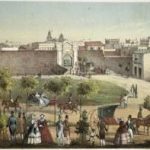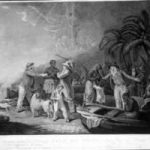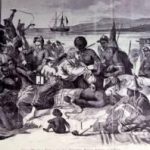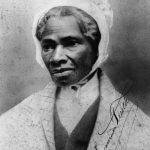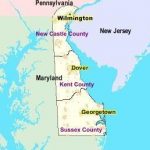Abolitionism was a political movement that sought to end the practice of slavery and the slave trade. ‘The Society for the Relief of Free Negroes Unlawfully Held in Bondage’ was the first American abolition society. It was established in Philadelphia in 1775, primarily by Quakers, who believed that one man owning another was a sin.
Its operation was suspended during the British occupation of Philadelphia and the Revolutionary War. It began again in 1784, with Benjamin Franklin as first president. At the Constitutional Convention of 1787, an agreement was reached that allowed the Federal government to abolish the international slave trade by 1808.
The principal organized bodies of this reform were the Society of Friends, the Pennsylvania Antislavery Society, and the New York Manumission Society. New York gradually abolished slavery beginning in 1799.
All of the states north of Maryland began to gradually abolish slavery between 1781 and 1804; all the states abolished or severely limited the slave trade. These acts typically allowed slaves born before the law was passed would be freed at a certain age, and so remnants of slavery lingered.
In the 1820s and 1830s, the American Colonization Society had gained broad support throughout the nation, with leaders like Henry Clay. It created an American colony in Liberia and assisted thousands of blacks in moving there. Disease was so prevalent there that most of the colonists died quickly, but enough survived to rule Liberia into the 1980s.
A radical shift in the antislavery movement came in the 1830s, led by William Lloyd Garrison, who demanded “immediate emancipation, gradually achieved.” He demanded that slaveowners establish a system of emancipation immediately. He and Arthur and Lewis Tappan, and others formed the American Antislavery Society in Philadelphia.
The majority of Northerners rejected the extreme positions of the abolitionists. Many northern leaders including Abraham Lincoln, Stephen Douglas, John C. Fremont, and Ulysses S. Grant married into slave-owning Southern families.
Among the early abolitionists were James Birney, John Pierpont, Gerrit Smith, Wendell Phillips, Charles Sumner, Maria Weston Chapman, Helen Garrison, Ann Green Phillips, Abby Kelly, Paulina Wright Davis, and Lucretia Mott.
When Angelina and Sarah Grimke began to lecture in New England, their audiences were at first composed entirely of women, but men soon began to slip into the back seats, one by one. Almost before the public was aware of it, these women were speaking in crowded meeting halls.
In the annual meeting of the Antislavery Association in May, 1840, a formal vote was taken on the appointment of Abby Kelley on a business committee, and was sustained by a majority in favor of woman’s right to take part in the proceedings of the Society.
Sarah and Angelina Grimke and Abby Kelley, in advocating freedom for the black race, were soon compelled to defend the right of free speech for women.
In the North, most opponents of slavery supported other reform movements, such as the temperance movement, public schooling, and prison reform, but they split bitterly over the issue of women’s rights.
The institution of slavery remained solid in the South, and that region’s customs and social beliefs evolved into a strong defense of slavery. But most Northerners favored a policy of gradual and compensated emancipation.
By 1849, abolitionists were demanding that slavery end immediately and everywhere. The abolitionist movement was strengthened by the activities of free African Americans, especially in the black church.
African-American activists were rarely heard outside the black community, but they were tremendously influential to some sympathetic whites, most prominently, William Lloyd Garrison. His efforts to recruit eloquent spokesmen among the former slaves led to the discovery of ex-slave Frederick Douglass.
Many Americans took an active role in opposing slavery by supporting the Underground Railroad. This activity was made illegal by the federal Fugitive Slave Law of 1850, but people like Harriet Tubman, Henry Highland Garnet, and Alexander Crummell continued their work and began to send the newly freed slaves to Canada.
After President Abraham Lincoln issued the Emancipation Proclamation in January 1863, abolitionists continued to actively pursue the freedom of slaves in the remaining slave states, and strove to better the conditions of black Americans in general.
The passage of the Thirteenth Amendment in 1865 officially ended slavery in America, though the struggle was far from over. A century later, African Americans in this country were still fighting for basic human rights.
